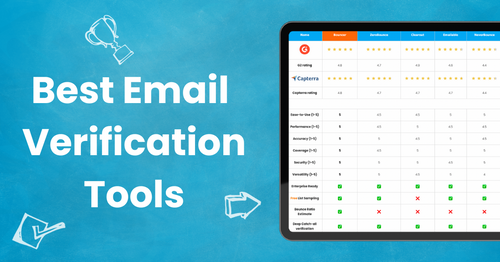In today's digital age, email communication remains one of the most effective means of reaching out to customers, clients, and colleagues. However, the success of email campaigns and the efficiency of your communication rely heavily on the accuracy of your email data. Enter email verification formats, a critical component of maintaining clean and reliable email lists. In this comprehensive guide, we will explore the intricacies of email verification formats, why they are essential, and how to implement them effectively to ensure your emails reach their intended recipients.
What is Email Verification Format?
Email verification format is the process of validating whether an email address conforms to the standard syntax and structure defined for email addresses. It ensures that an email address is correctly formatted, minimizing the chances of sending emails to invalid or non-existent addresses. This verification process is crucial for several reasons, including:
Data Accuracy: Accurate email data is the cornerstone of any successful email marketing campaign. By verifying email formats, you can reduce bounces, improve open rates, and enhance your sender reputation.
Enhanced Deliverability: Internet service providers (ISPs) and email services use various filters to prevent spam and ensure the delivery of legitimate emails. If your emails consistently bounce or get marked as spam, your sender reputation suffers. Proper email verification can help maintain a positive reputation, ensuring your emails land in the inbox rather than the spam folder.
Cost Savings: Sending emails to invalid addresses not only wastes resources but can also lead to increased costs with some email marketing platforms charging based on the number of emails sent. By verifying email formats before sending, you can save on unnecessary expenses.
The Anatomy of an Email Address
Before delving into email verification formats, let's dissect the components of a standard email address. An email address typically consists of two parts:
Local Part: This is the part of the email address before the "@" symbol. It can contain letters, numbers, and special characters, such as periods, underscores, and hyphens.
Domain Part: This is the part of the email address after the "@" symbol and typically includes the domain name of the email provider (e.g., gmail.com, yahoo.com).
Now that we understand the basic structure of an email address, let's explore various methods and tools for verifying email formats effectively.
Methods for Email Verification Format
Regular Expressions:
- Regular expressions (regex) are patterns used for matching character combinations in strings. They are a powerful tool for email format validation. For example, a common regex pattern for email validation is:
^[a-zA-Z0-9._%+-]+@[a-zA-Z0-9.-]+\.[a-zA-Z]{2,}$
This pattern checks if an email address adheres to the standard format.
API-Based Solutions:
- Several API services, such as Verifalia and Abstract API, offer email verification services. These APIs can quickly validate email addresses in real-time, saving you the hassle of developing your own verification logic.
Programming Libraries:
- Programming languages like Python, JavaScript, and C# provide libraries and functions for email format validation. For instance, in C#, you can use
System.Net.Mail.MailAddressclass to validate email addresses.
Third-Party Tools:
- Numerous third-party tools and email marketing platforms include built-in email verification features. These tools can validate email addresses in your list and provide reports on the quality of your data.
Best Practices for Email Verification
Now that we've covered the methods, let's discuss best practices for implementing email verification formats effectively:
Real-Time Validation: Whenever possible, verify email addresses in real-time during the sign-up or data entry process. This ensures that only valid email addresses are accepted.
Batch Validation: Periodically run batch validation on your entire email list to identify and remove invalid or dormant addresses. This helps maintain data accuracy over time.
Implement Retry Policies: In case of temporary issues during verification (e.g., DNS problems), implement retry policies to give the email address a chance to be validated.
Use Multiple Verification Methods: Combine regex pattern checks with API-based verification for comprehensive email validation. This reduces false positives and negatives.
Update User Records: When an email address is found to be invalid, prompt users to update their email addresses for future communications.
Commonly Asked Questions About Email Verification Formats
1. Can email verification catch all invalid addresses?
- While email verification formats can catch many invalid addresses, they cannot guarantee 100% accuracy. Some email addresses may appear valid but still bounce due to other issues, such as a full inbox.
2. Is email verification necessary for small businesses?
- Yes, email verification is essential for businesses of all sizes. It helps maintain data quality, reduces costs, and ensures that your emails reach the right recipients.
3. How often should I perform email verification on my list?
- It's advisable to perform batch email verification regularly, especially if you have a large email list. Real-time validation should be used during data entry or sign-up processes.
4. Are there free email verification tools available?
- Yes, some free email verification tools and libraries are available. However, for comprehensive and real-time verification, it's often worth investing in paid services or using the built-in features of email marketing platforms.
5. Can email verification prevent all email bounces?
- While email verification can significantly reduce email bounces, it cannot eliminate them entirely. Bounces can still occur due to factors like a recipient's inbox being full or the email server being temporarily down.
In conclusion, email verification formats are a critical component of maintaining clean and reliable email lists. By implementing best practices and using the right tools, you can ensure the accuracy of your email data, enhance deliverability, and ultimately achieve better results from your email marketing campaigns. Stay proactive in managing your email lists, and your communication efforts will reap the rewards in the form of improved engagement and customer relationships.



